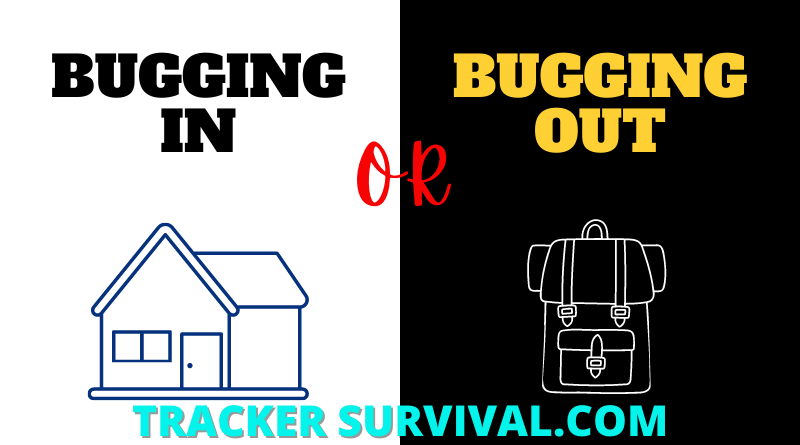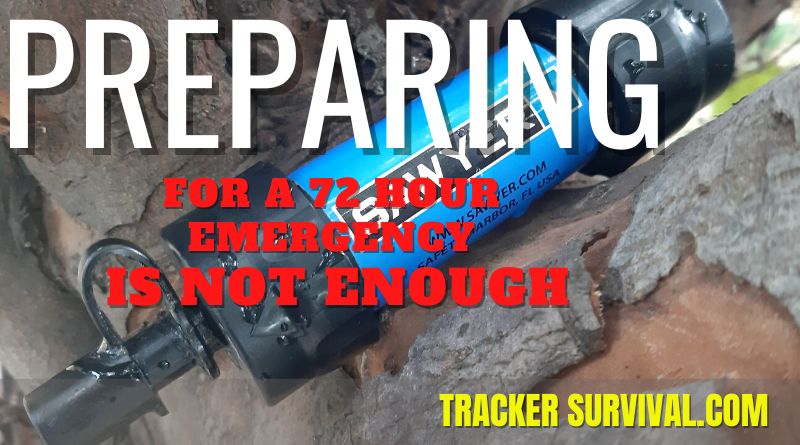Bug In Vs Bug Out, When Bugging In Is The Better Option
There is so much hullaballoo about bugging out, “prepare a bug out bag”, “get a bug out vehicle”, but bugging out is not always the best move. When bugging in is the better option, make sure that the home is prepped and ready. So bug in vs bug out, are you ready to bolt the doors and shutters? Or are all your plans only based on bugging out?
72-Hour Emergency Prep Rule, is it Enough?
The rule of thumb used to be that prepping for a 72-hour emergency was enough. But what happens if the emergency lasts longer than that? Take for example what happened during the disaster that was Hurricane Katrina (For More Information on Katrina and how the Government responded Click LINK). For many bugging out was not an option, but hunkering down with 72 hours of supplies was woefully insufficient.
A 72-hour bug-out bag is exactly as the name implies, a kit designed to help you survive for 72 hours while you are bugging out. The question is should you be bugging out, and if you are, where are you bugging out to? and will it only be for 72 hours? Will it take 72 hours to reach the bugout location? Does the bug-out location have extra supplies that will last the duration of the emergency?
Bugging Out vs Hunkering down
Not every situation requires you to bug out, sometimes hunkering down and riding it out is the better option. If hunkering down is what you are doing, then you need to ask yourself,
Do you have enough resources to survive where you are?
Do you have sufficient water?
Do you have sufficient food or a method to acquire more food (foraging, hunting, farming, trapping, fishing, etc)?
Do you have the medicine(if you need it) to survive for an extended period of time?
Does your shelter protect you from the elements, is it waterproof, warm enough, and safe?
How long will it take for rescue services or aid to arrive? Don’t expect a quick response.
Governments are notoriously slow to respond to national disasters. Often taking weeks or even months before any significant help arrives.
For example in the case of Hurricane Sandy, its effects lasted significantly longer than 72 hours, and people who had prepared themselves for 72-hour emergencies found themselves in dire straits, having to rely on neighbours or just having to do without.

Preparing to Ride Out the Storm
This is not an exhaustive list of what you might need, it is the minimum recommended items that you should have in your home if you are planning to stay rather than bug out.
One gallon (the minimum) of water per person per day for drinking and very basic sanitation (3 gallons per person would be much better)
Sixty days’ worth of non-perishable food
Sleeping bag for every member of your family (a couple of spare blankets per person)
Clothing suitable to your environment without Utilities, plan for no gas or power (with 2 pairs of extra socks, a hat, pair of gloves, protective glasses, shemagh, or bandana).
Trauma Kit and First Aid kit (include N95 masks and extra nitrile gloves)
Water-purification devices (eg: Sawyer Mini, Life Straw, Katadyne, purification tablets, etc)
Fire-making devices (eg: lighters, matches, ferrocerium rods, magnifying glass, etc)
Battery-powered radio and NOAA weather radio (optional: Walkies do come in handy)
Flashlights, headlights, light-sticks, and candles (never underestimate the benefits of candles)
Extra batteries for all devices and a couple of portable power-banks
Whistle for signalling for help (if you have ever been injured or exhausted and tried calling out for help continuously for extended periods of time, you will know how tiring it is, and how much more effective and easier a simple whistle is)
Thick Plastic sheeting and duct tape (to make emergency repairs to your home, fix a window, etc)
Heavy duty garbage bags (multiple uses)
Sealable plastic buckets (multiple uses)
Wet wipes (you will really appreciate having these), antiseptic soaps, alcohol wipes, and basic sanitation items
A way to cook food that does not rely on the grid, for example, wood burning stove, propane cooker, or even a portable BBQ grill will work in a pinch
Things Specific To YOU And Your Families Needs.
Think of things that you may need that are specific to you or your family for example:
Do you need prescription medications?
Do you have children?
Elderly parents, who have special needs?
Pets?.
How To Plan What To Stock Up On
The best way to do this is to keep track of all your purchases for the last 3 months, have a look through your receipts, and list down the recurring necessities that are essential (eg: medication, baby formula, diapers, pet food, etc) and start stocking up on those.
Preparing for a 72-Hour Emergency Is NOT Enough
During the Zagreb Earthquake on the morning of 22 March 2020, people were waiting on the streets in the wee hours of the morning for hours, many were huddled in cars with the meagre belongings they managed to grab on the way out. Many were in pyjamas without proper clothing, shivering in the cold. No water or food and no Bug Out Bag. In Fact, on our street, I did not see a single person who was prepared.
There was no shortage of food or water. But if there had been, we had about 30 days worth in our home. Which sadly was badly damaged by the earthquake. But the food was still accessible. So not a total loss.
We had Sawyers Mini Water Filters and used those to good effect. The government stated that the water supply was not contaminated, but there was no harm in being extra careful. So we filtered all our drinking water.
We had blankets and a tarpaulin in the car, so we wrapped those around my mom to keep her warm while the aftershocks hit every few minutes.

Turn OFF Utilities
If you can safely enter your home. During an emergency, it would be wise to turn utilities off. Turning off the gas and water at the mains is a wise safety precaution. Flipping the breakers off at the main junction box would also be a good idea.
Once the disaster is over, and have you judge that it is safe. Check if there was any damage and if there wasn’t. Then turn it all back on.
Bug-Out Bag Has All You Need For 72 Hours
Prepping for a short-term emergency is great. A well-packed bug-out bag will be sufficient for that. For a Free Bugout Bag Checklist Click HERE
Prepping For The Long Haul
The most difficult items to stock up on are items used up in large quantities or items that are difficult to replace. Such as toilet paper, diapers, or medicine. There are solutions to some, such as just not using toilet paper or diapers. But prescription medication is a problem. Many of these are prescriptions are filled monthly, so you would need to explain to your doctor that you are prepping and hope that he understands.
We are not discussing sustainability, so I will not bring up home-steading, instead, let us discuss prepping.
Storing Water
Before public water was so commonly available, cisterns were a common sight in nearly every household. Surprisingly not that long ago. In rural areas, many homes pre-1940s had cisterns to store water. And pre-1920 only a small minority of homes had electricity and running water.
Installing a cistern for sanitation uses would be wise, and storing potable water in water bricks (if you can afford them would be great). Collecting water from rain run off a roof into a cistern is relatively simple. Just funnel it from your gutter into a container. Voila. Then it is a matter of filtering the water and making it usable for sanitation uses. It can even be processed into potable water if the situation warrants it.
The CDC recommends at least 1 gallon of water per person per day for emergency use. I recommend 3 times that.
Medicine
This is possibly the most difficult to fabricate in a SHTF scenario. There are homeopathic remedies for many minor ailments. But they do not compare to prescription medication. If possible, stock up on at least 3 to 6 months’ worth of prescription medication.
Have a well-stocked First Aid Kit and Trauma Kit. And remember to get First Aid Training as well.
Food
With modern packaging and methods of preservation, long-shelf life food items are easily accessible to the general public. Dehydrated foods, canned, pickled, and even MREs are good options for long-term storage. Some of these can last up to a decade. But that does not mean they will taste great. So rotate your stock regularly and consume them well before expiry. And remember this essential rule when it comes to stocking up on food “Eat what you store, Store what you eat”.
Not sure who to credit that phrase to, but it sure does apply.
Warmth
In some parts of the world this is not an issue, but in areas that get cold weather. Stocking up on firewood, and cold weather clothing may be essential.
How Prepared Is Your Home?
Calculate What Is In Stock
Evaluate how prepared your home is if a disaster struck and chains of supply were broken. How long before restocking would be necessary. Calculate all the resources available. Water, food, medicine, sanitation products, etc.
Build Up Stock
Build up a stock gradually over time, increasing from 2 weeks to 2 months, and then longer.
There is no rule of thumb to how much stock should be kept. Some say 3 weeks is sufficient, others say 3 months. There are preppers who have years worth of supplies. The 2 biggest constraints would be monetary (stockpiling is expensive) and space (years worth of stock take up a lot of space). Want to start stocking up on food? learn how in our food stores for emergencies.
Stocking Up On Water
As for water, unless you have a lake in the backyard. Stockpiling water for long periods is nigh on impossible. A method of replenishing supplies would be necessary. Either from rainfall or groundwater. Here are some tips on what to do when the taps run dry.